Slack vs Microsoft Teams Statistics By Revenue, Users And Demographics (2025)
Updated · Sep 01, 2025

Table of Contents
Introduction
Slack vs. Microsoft Teams Statistics: In 2024, these two giants were battling it out in the global collaboration arena. Teams, included within the Microsoft 365 suite, had an extraordinary 320 million monthly active users, whereas Slack, albeit smaller, commanded a niche group of 42 million daily and 65 million monthly active users.
This article on Slack vs. Microsoft Teams statistics consequently considers the user base numbers, market share, price, features, integrations, usage trends, and overall impact, all supported by hard numerical percentages.
Editor’s Choice
- Microsoft Teams had 320 million monthly active users in 2024, way beyond 65 million monthly and 42 million daily active users of Slack.
- By 2025, Slack was projected to reach $4.22 billion in revenues worldwide, whereas Microsoft Teams surpassed the $8 billion mark in 2023, jumping from $6.8 billion in 2020.
- Microsoft Teams revenue grew rapidly early on, from $10 million in 2017 to $800 million in 2019 and $7.7 billion in 2021, quite outpacing Slack’s steadier growth graph.
- In 2023, Slack had about 32.2 million daily active users (DAUs) and was forecasted to see this number jump to 38.8 million in 2024, while Teams maintained at a massive 320 million DAUs.
- Monthly active users of Slack increased from 43.1 million in 2022 to 54.1 million in 2023 and will become 79 million in 2025; the daily engagement being so high with Teams indirectly envisages a much larger MAU base.
- Slack has a focus on startups and SMBs, registering 63,035 users from companies making $1–10 million annually, whereas Teams has a stronger enterprise presence but does not give any revenue-delineated user figures.
- Slack is much more popular amongst younger users, especially those in the 25 to 34 age group (33.29%); Teams has a stronger presence among users who fall into the 35 to 44 (31.23%) and 45 to 54 (29.98%) age groups.
- With 20.82% of its users aged 55+, Microsoft Teams holds a segment fairly well, for which Slack fares less well at 9.62% (55–64) and 6.68% (65+).
- Slack dropped its rank in U.S. mobile traffic to 92 in March 2023 from 88 in February, whereas global traction remained much more impressive for Microsoft Teams.
- In the Middle East and Africa, Teams reached 8.6 million downloads, while in the Asia-Pacific region, the number was above 129 million in Q2 2020; compared to these, Slack was lowly downloaded: 900K downloads in February 2023.
- In February 2023, downloads of Slack were distributed as 600,000 on iOS and 400,000 on Android, with the main app accounting for the majority; by 2020, Microsoft Teams had already surpassed 75 million daily users.
- The Slack Android app surpassed 10 million collective downloads by March 2023, with a 3.7- star rating from 122,000 reviews; meanwhile, Teams enjoyed continued benefits from its integration into the Microsoft ecosystem.
- In app usage behaviour, 52.9% of traffic to Slack came from direct visits; 43% came via search; and just 3.6% were referred. Teams, by enterprise integration, had a deeper and broader engagement.
- Slack Android users visited productivity apps (17.7%), communication apps (16.4%), and business tools (6.7%), suggesting some overlaps in app ecosystems. Teams are far more deeply sewn into the productivity suite of Microsoft.
Slack vs Microsoft Teams Revenue
Slack Revenue
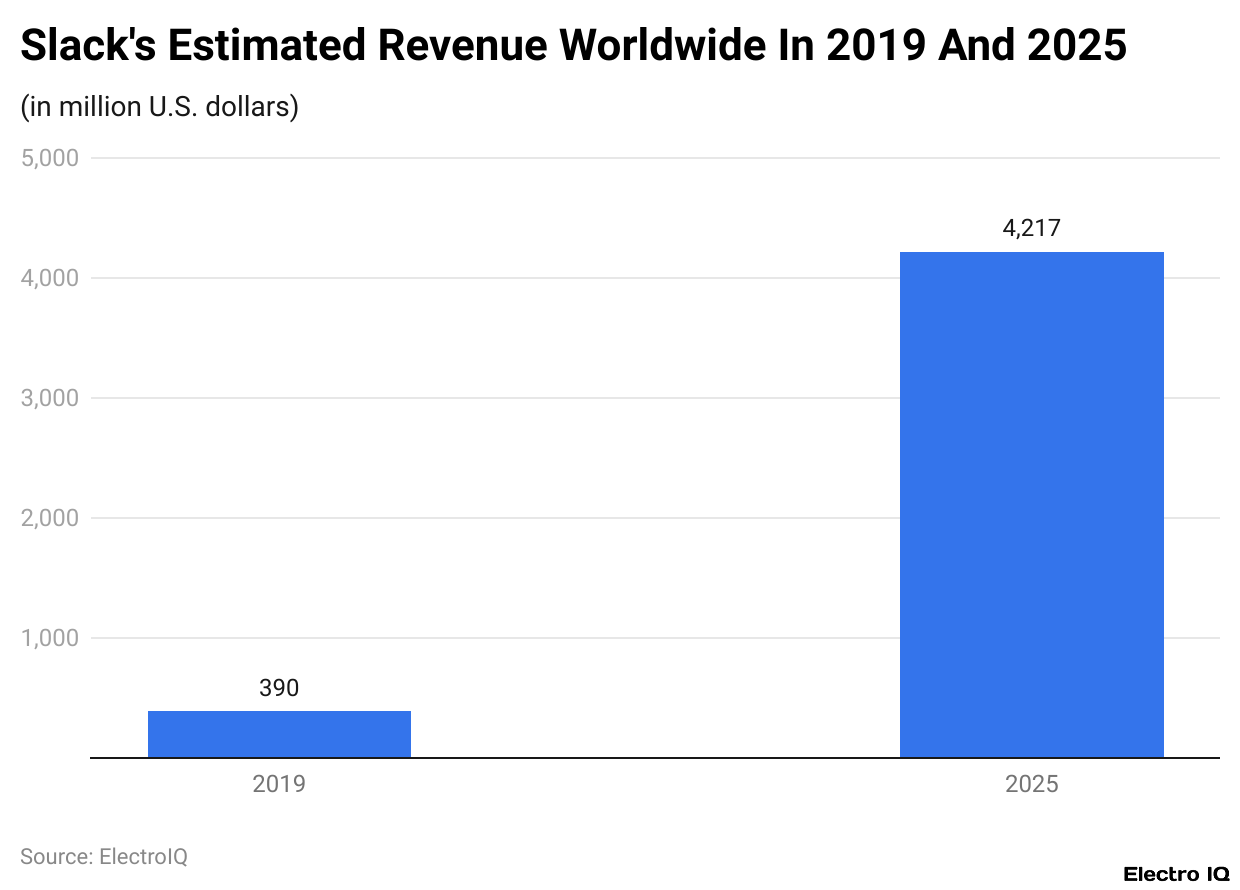
(Reference: statista.com)
Microsoft Teams Revenue
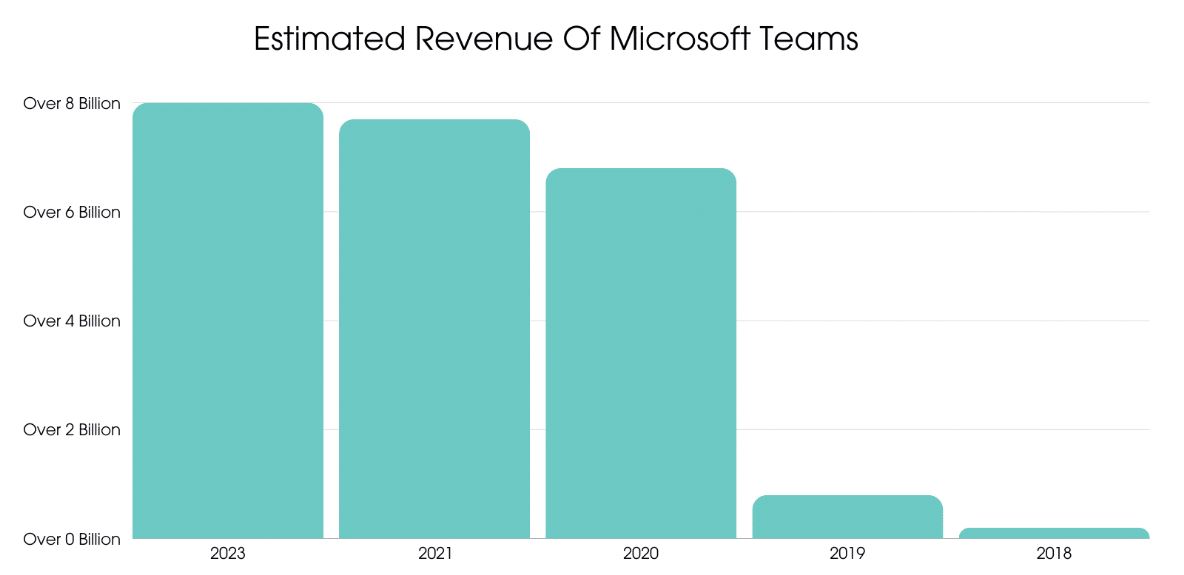
(Source: statista.com)
- The GP Bullhound report Slack vs Microsoft Teams statistics predicts that Slack will generate $4.22 billion in revenue worldwide by 2025, embellished with a higher estimation due to the growth trajectory of the digital communication and collaboration industries. This estimation translates the continued upward trend of Slack in revenues, which proves the phenomenon of demand in remote and hybrid working environments.
- The revenue increases year by year, driven by the momentum of widespread user adoption for team communication.
- Meanwhile, compared to Teams by Microsoft, the revenue growth has been much steeper and faster ever since Teams came into existence in 2017.
- It was just $10 million for the first year, but it quickly breached $200 million in 2018 and grew to $800 million in 2019.
- Then the pandemic hit in 2020, and it exploded the revenue as the platform for remote work solutions.
- Now it is almost $8 billion with an estimated revenue of $7.7 billion in 2021 and reached $8 billion plus in 2023, which has cemented its place in the top ranks.
- Because of the integration with Microsoft 365 and enterprise acceptance during and after the pandemic, Microsoft Teams has generated revenues in leaps and bounds than Slack. Slack, on the other hand, uses an approach that emphasises the usability of its platforms, innovation, and adoption by agile teams and mid-sized organisations.
Slack vs Microsoft Teams Active Users
Slack Active Users
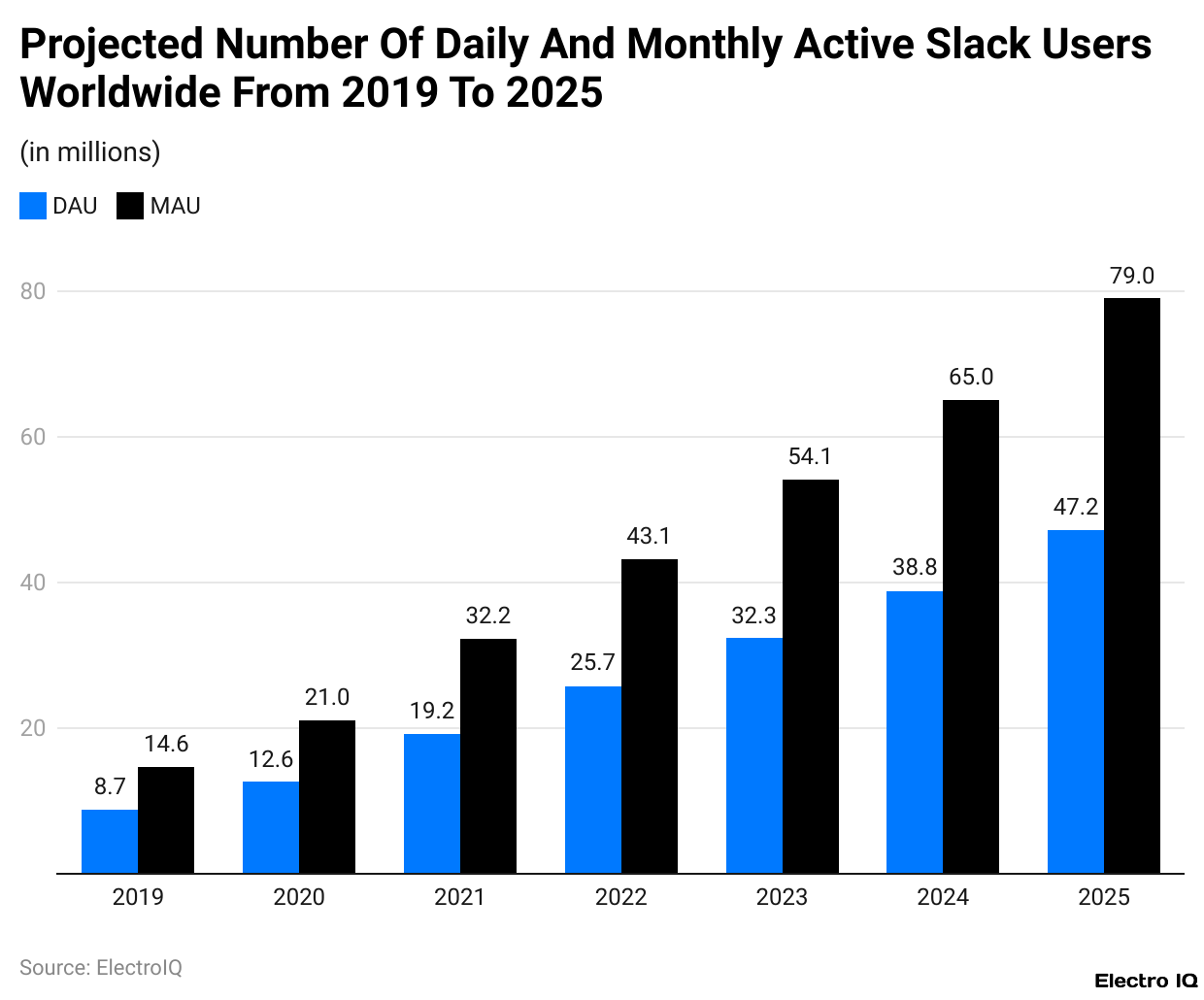
(Reference: statista.com)
Microsoft Teams Active Users
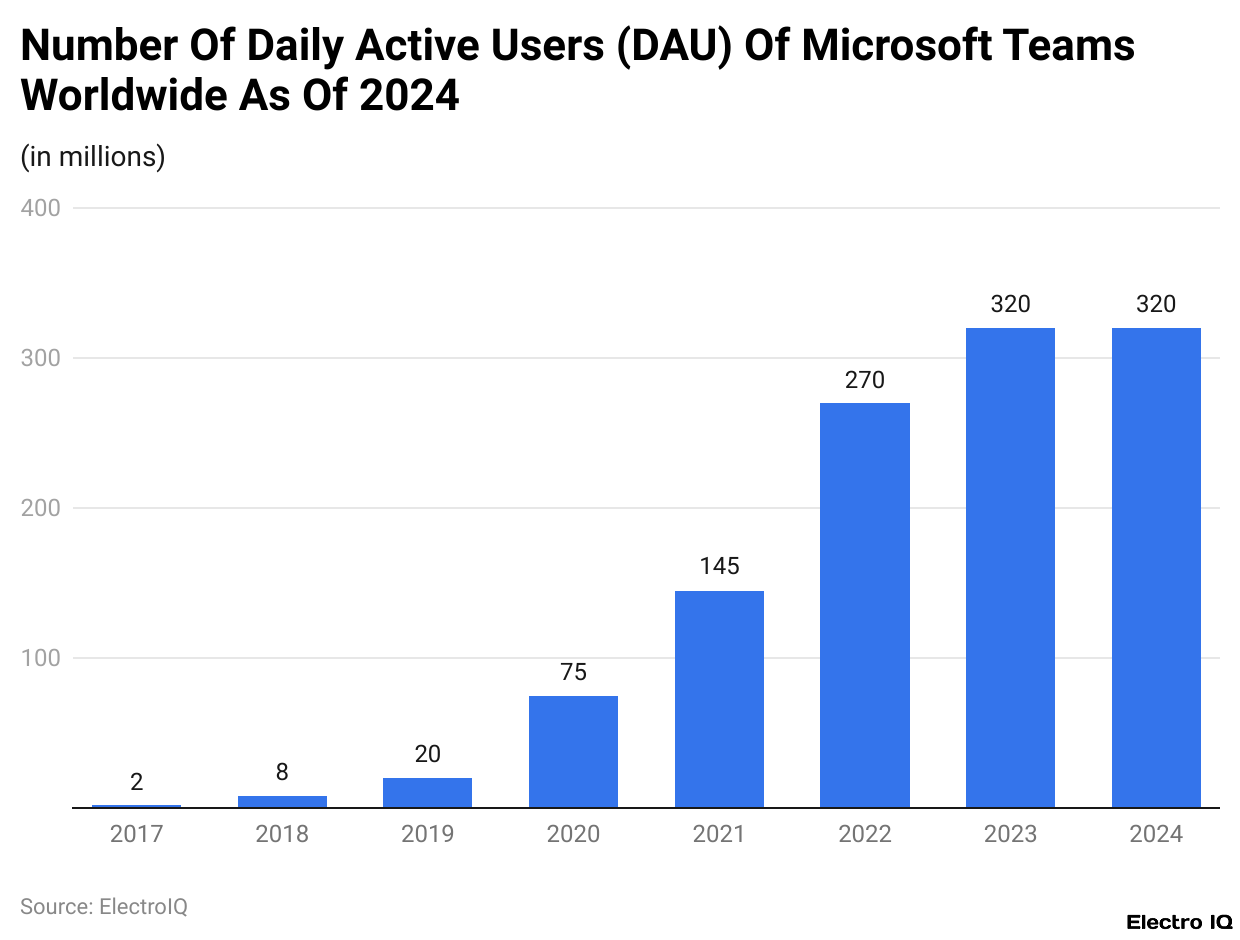
(Reference: statista.com)
- According to a Statista report, Slack vs Microsoft Teams statistics state that in 2023, Slack gained another big leap in daily active users, going from 25.7 million in 2022 to about 32.2 million, while Microsoft Teams recorded about 320 million daily active users, which is significantly higher throughout the entire year.
- The user growth of Slack will continue, with daily active users being anticipated to rise to 38.8 million in 2024 and to 47.2 million by the end of 2025, whereas Microsoft Teams has already saturated the market at a far larger scale.
- In reference to monthly active users, Slack grew its numbers from 43.1 million in 2022 to 54.1 million in 2023, with projections showing a rise to 65 million in 2024 and 79 million by 2025.
- In contrast, whereas Microsoft Teams’ MAU figures are never broken out, their tremendously high daily usage speaks of a strong engagement base from corporate adoption and integration with Microsoft 365.
- The rapid rise in Slack’s user base exhibits growing worldwide interest from businesses and organisations toward more flexible and integration-rich teaming tools.
- Alongside this, the huge dominance of Teams is attributed to its inclusion inside Microsoft 365 and the fact that it was the go-to application for teamwork during the Coronavirus pandemic, which saw daily home internet data usage in the USA jump by 4.4 GB, almost a 40% increase compared to March 2019.
- This overall trend gave a boost to the growth of platforms, such as Teams, when demand increased for video conferencing, messaging, and collaboration across devices, stretching from smartphones to gaming consoles.
- While Slack is steadily growing, gaining favour among smaller teams and startups, Microsoft Teams remains the strongest in the enterprise communication domain, courtesy of its early scaling during the pandemic and bundling of its product.
Slack vs Microsoft Usage By Industries
Slack
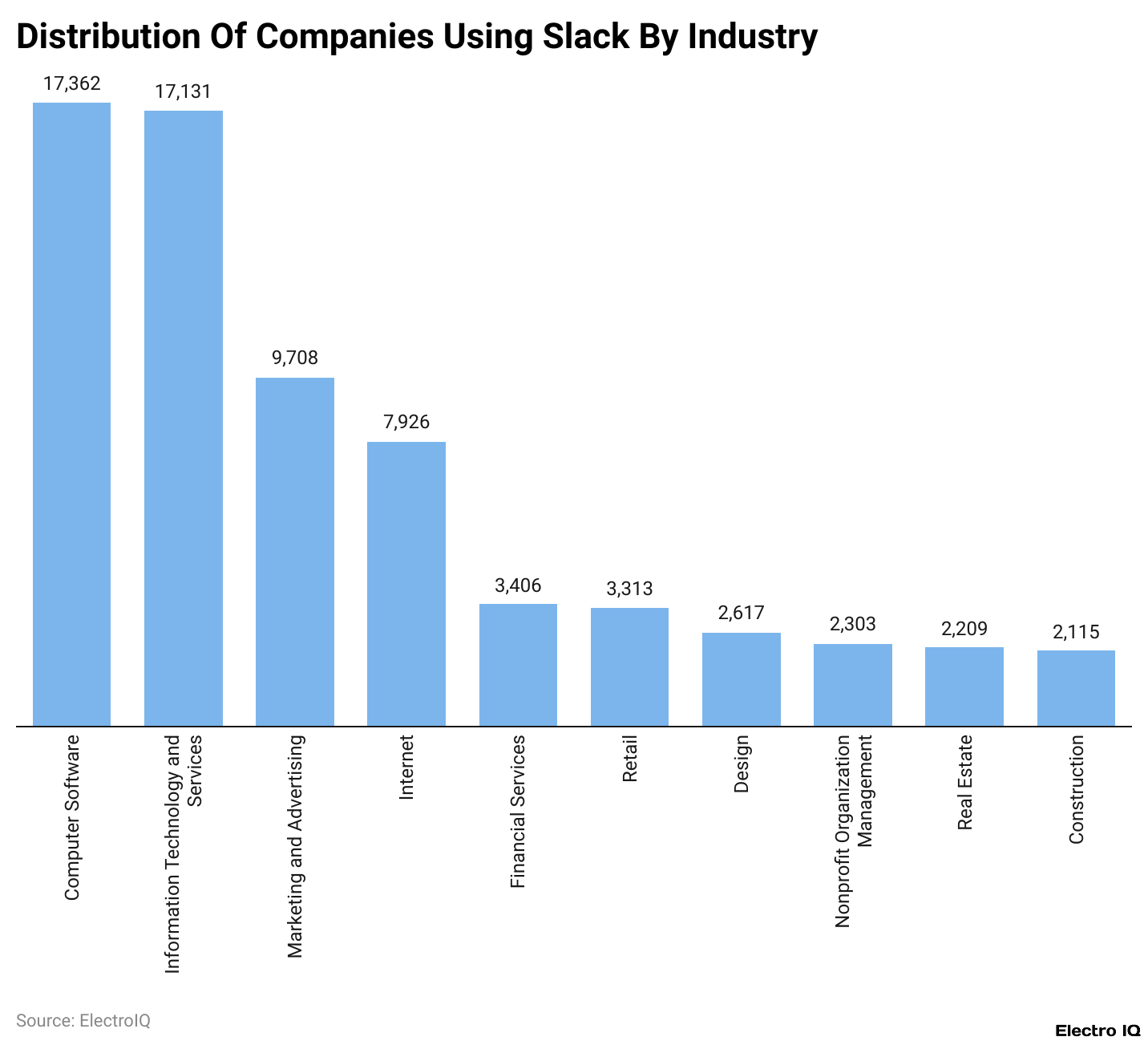
(Reference: enterpriseappstoday.com)
Microsoft Teams

(Reference: usesignhouse.com)
- In contrast, the user distribution of the two platforms indicates different areas of strength. Across the spectrum of Information Technology and Services, both platforms enjoy high adoption; Microsoft Teams stands far ahead with 29.6% of its user base coming from this sector, whereas only 13% of Slack’s users are from the same sector.
- Similarly, while 12% of Slack’s users hail from Computer Software companies, Teams is not far behind, with 11.8% coming from this sector, showcasing an almost equal relevance in tech-centric environments.
- When it comes to Marketing and Advertising, Slack has 7% of users coming from this industry, while Teams has 4.3%.
- Also, Slack counts 6% of its users from the Internet sector, which is not distinctly outlined in Teams’ breakup.
- In numbers, Slash depicts higher users, with 16,577 in IT Services and 15,480 in Computer Software, while Teams keeps mum on the actual user count but shows higher %age dominance.
- With 9,551 Marketing and Advertising users and 7,452 Internet users, Slack enjoys more presence in those areas.
- Teams, in contrast, sees usage in schooling or higher education in a percentage of 10.6 %, with another 8.3 % of users in education management. These categories are hardly shown in the presence of Slack.
- Teams users in healthcare and hospital management make up 9.6 %, with another 8.2 % coming through NGOs, thereby clearly favouring Teams.
- Slack, on the other hand, carries small user bases in Financial Services (3,259), Retail (3,113), Design (2,671), Non-Profit Management (2,303), Real Estate (2,209), and Construction (2,115), all somewhat smaller in number compared with government at 5.8 % and finance at 7%, operating under Teams’ umbrella.
- From a revenue bracket perspective, Slack obtains the largest user base of 26,528 users coming from firms earning under one million US dollars annually.
- Firms earning between one and ten million US dollars account for 63,035 users, showing strong traction in the SME area.
- Higher revenue size tiers see 3,670 users come from companies of revenues US$10–50 million, 2,023 from the $100-$200 M category, 2,051 from the $200 M–$1 B category, and 1,622 from companies above $1 B in revenues.
- Revenue-wise, user distribution is not disclosed by Microsoft Teams, but given its stronger appeal to the enterprise and public sectors, there may be a concentration of large-scale or institutional users. While overall, it seems Slack is dominated by startups, tech, and marketing firms, Microsoft Teams dominates larger enterprises, education, government, and private health sectors.
Slack vs Microsoft Teams Age Demographics
Slack Demographics
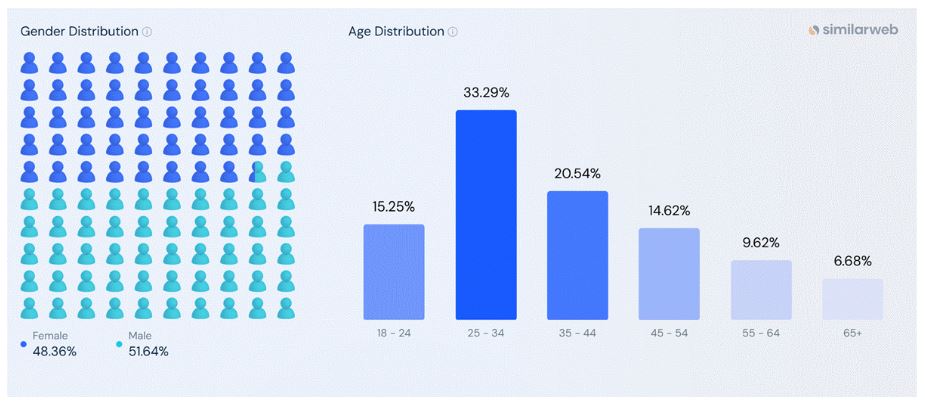
(Source: similarweb.com)
Microsoft Team Demographics
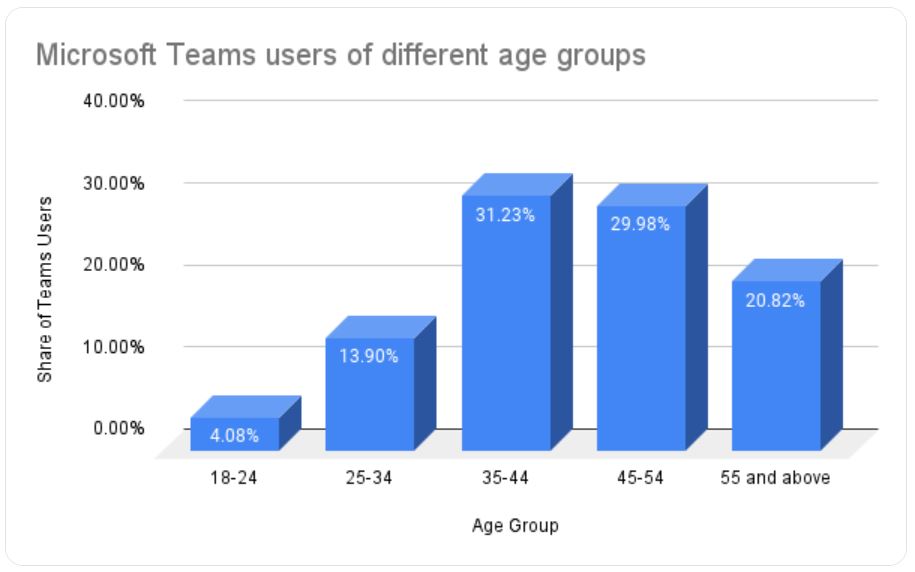
(Source: notta.ai)
- According to Smiliarweb and Notta ai, Slack vs Microsoft Teams statistics reveal that Slack has almost equal male and female representation at 48.36% and 51.64%, respectively. Microsoft Teams, on the contrary, does not unveil a gender-wise split but does have demographic results showing different usage patterns with age.
- In terms of age demographic comparison, Slack stands out as the most popular tool among the 25-34 years age group, which makes up 33.29% of the overall users.
- For Microsoft Teams, the 35-44-year-olds use it the most, forming 31.23% of the users. The second-largest group for Slack is aged 35 to 44, at 20.54%, while for Teams, it’s 45 to 54-year-olds at 29.98%.
- The youth-age category of 18 to 24-year-olds really just represents 15.25% of Slack’s userism, whereas Microsoft Teams have this same category well down at just 4.08%. This would indicate that Slack holds appeal for younger professionals or students compared to Teams.
- Further trends were observed in the older age groups, such as 45-year-old-to-54-year-old Slack users at 14.62% and those between 55 and 64 at 9.62%, with the above 65 at 6.68%.
- On the contrary, Microsoft Teams has a much larger share of older users at 20.82%, above age 55.
- Overall, while Slack seems more preferred by the younger crowd with an evenly distributed age group, Microsoft Teams, on the other hand, remains very much the choice of the older professional, especially within the intermediate years of 35 to 54, thereby underlining its dominance in enterprise and commercial environments.
Slack vs Microsoft Teams App Statistics
- In early 2023, the Slack Android app ranked 92nd for traffic in the United States, slipping from its earlier position of 88th in February, whereas Microsoft Teams achieved much greater regional success, with some 8.6 million downloads in the Middle East and Africa.
- While Slack ranked 79th in Canada across all app categories, Teams exploded in regions such as Europe, the Middle East, and Africa, where its use increased by more than 750% between late 2019 and early 2020.
- Slack witnessed 52.9% of its direct traffic in February 2023, 43% from searches, while Microsoft Teams truly benefited from this wider adoption of remote work.
- The users of the Slack Android app shared a common interest in productivity apps (17.7%), communication tools such as WhatsApp and Gmail (16.4%), and professional platforms such as LinkedIn and Zoom (6.7%).
- Concerning Microsoft Teams, the standing of digital collaboration generally was advantageous, seeing gigantic increases in meeting usage and downloads, especially throughout the COVID-19 pandemic.
- In February 2023, 900,000 downloads were recorded for Slack, 600,000 on the iOS platform, and 400,000 on Android.
- During the second quarter of 2020, Teams had a total of 129 million downloads throughout the Asia-Pacific region.
- Atop the Slack app ecosystem was the main Slack app, able to garner 600,000 downloads, while secondary apps such as Slack for EMM and Spec by Slack performed poorly, under 10,000 and 5,000 downloads, respectively.
- Surpassing 75 million daily users in 2020, Teams reached 320 million active users by 2023.
- The Android version of Slack arrived in the 10-million-download club on March 17, 2023, with an average rating of 3.7 stars from about 122,000 reviews.
- By contrast, Microsoft Teams continues to hold sway as the tool of choice that has relevance for hybrid workplace setups, where people are spending 10+ hours in virtual meetings weekly, as research done in 2023 confirmed.
- Lastly, while Slack focused more on team collaboration and integrations, Teams gained popularity because it was embedded inside the broader Microsoft ecosystem, which kept on evolving with rising email usage.
- More than 10 billion emails were sent daily in the U.S. in April 2024, followed by Germany with 8.5 billion, and Ireland with 8.4 billion. Despite having just 4.06% of email opens versus 55% for Apple’s and 30.57% for Gmail, Outlook’s presence was maintained through its integration with Microsoft Teams.
Conclusion
Slack vs Microsoft Teams Statistics: In the year 2024, Microsoft Teams became the uncontested leader for conversation and collaboration tools, dominating with an enterprise reach and mobile adoption. Slack holds a strong position, with a market share of about 18-22%, offering a highly customisable environment with rich integrations to boost productivity.
Teams are well-suited to large enterprise scenarios, offering bundled value, governance, and far deeper Microsoft integration. Slack best serves flexible, agile, user-centred workplaces, especially outside rigid Microsoft 365 environments.
FAQ.
Microsoft Teams considerably outclasses Slack in terms of users, having had 320 million MAUs in 2024, whereas Slack is estimated to have 65 million MAUs and 42 million DAUs. The user superiority of Teams comes mainly from the integration with Microsoft 365 and large enterprise adoption.
Microsoft Teams leads in revenue, generating over $8 billion in 2023, up from $6.8 billion in 2020. In contrast, Slack is projected to reach $4.22 billion in global revenue by 2025, showing steady but slower growth. The fact that Teams is bundled with Microsoft 365 accelerated its financial dominance alongside its early pandemic adoption.
IT service, education, healthcare, and government are all led by Microsoft Teams. Slack, conversely, takes marketing and advertising (7%), internet/tech startups, and, at least in terms of small to mid-sized enterprises, perhaps the strongest user base there.
Slack is popular primarily with young professionals: 33.29% of users are between 25 and 34 years old, and there is a balanced gender split. On the other hand, Microsoft Teams tends to draw an older crowd of the 35-54 category, with more than 61% of its users falling therein, and 20.82% belong to the age group of 55 and above, being too industry-oriented.
While rubbing shoulders with 129 million Asian-Pacific downloads alone in the second quarter of 2020 and 8.6 million in the Middle East & Africa, Microsoft Teams very well takes the crown for the highest global downloads, witnessing deep levels of implementation throughout enterprises. In contrast, Slack recorded 900,000 downloads in February 2023 (600,000 for iOS and 400,000 for Android) and crossed the 10-million mark for total Android downloads.

Maitrayee Dey has a background in Electrical Engineering and has worked in various technical roles before transitioning to writing. Specializing in technology and Artificial Intelligence, she has served as an Academic Research Analyst and Freelance Writer, particularly focusing on education and healthcare in Australia. Maitrayee's lifelong passions for writing and painting led her to pursue a full-time writing career. She is also the creator of a cooking YouTube channel, where she shares her culinary adventures. At Smartphone Thoughts, Maitrayee brings her expertise in technology to provide in-depth smartphone reviews and app-related statistics, making complex topics easy to understand for all readers.










